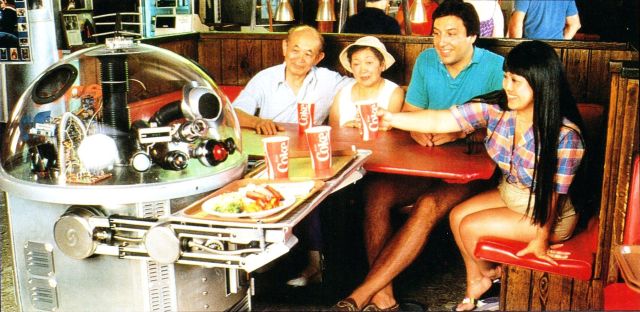
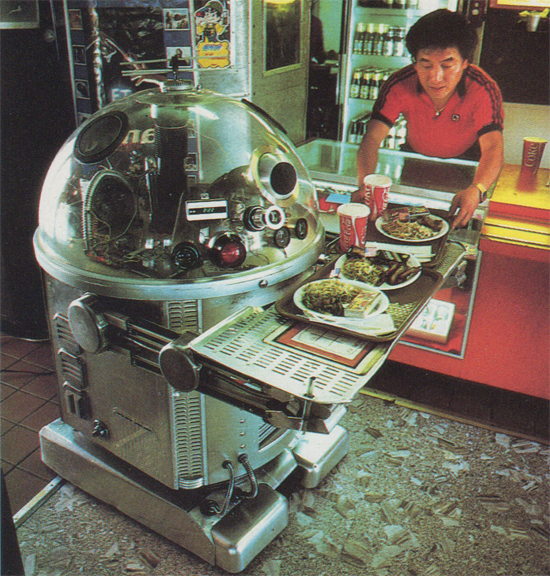
The Japanese owner of a Chinese restaurant in Los Angeles has installed a robot waiter because he thinks they are more efficient than his human waitresses. The robot carried trays of food and other orders on March 11 to the waiting customers and was well received by the patrons. One customer was satisfied with the speed with which his meal was delivered. Spanish-speaking Hernando Monzon was pleased with being able to order in his owner language. The restaurant owner, Shayne Hayashi, said that he was happy with the robot because he did not have any worries about absenteeism, personality problems of troublesome staff. One customer was also satisfied because the robot never spoke back and needed no tips. Hayashi said the only drawback was when the robot's batteries ran down and had to be recharged.
[Source: www.itnsource.com]
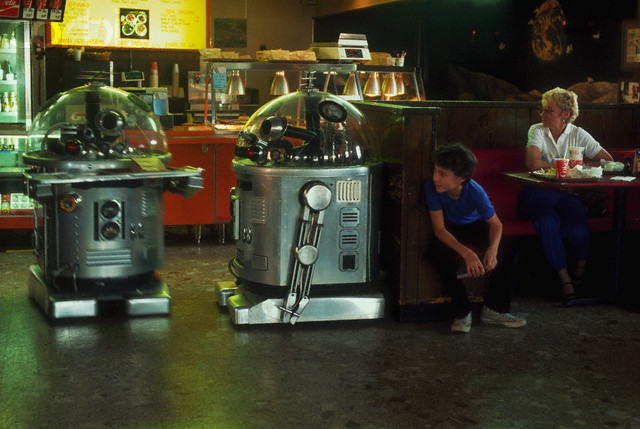
Tanbo R-1 and R-2.
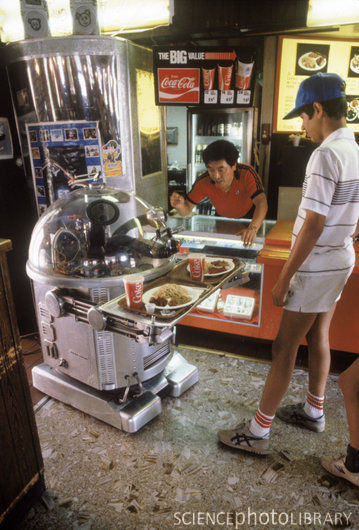
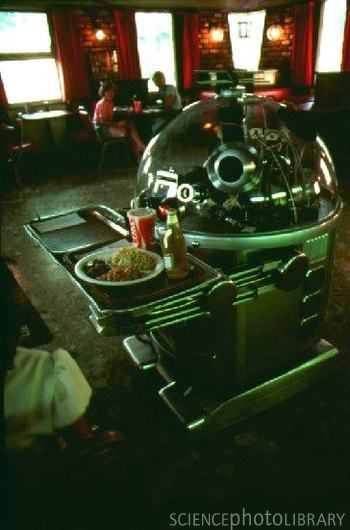
[Source for below text: Paleofuture ]
In 1983, a Chinese fast-food restaurant in Pasadena, California hired a curious-looking pair of servers: two robots named Tanbo R-1 and Tanbo R-2.
At 4.5 feet tall and 180 pounds, the robots would scoot around; bringing trays of chow mein, spareribs and fortune cookies to customers’ tables.
Shayne Hayashi, the owner of Two Panda Deli, first put the robots to work in 1983. Each Japanese-built robot purportedly cost $20,000 (about $45,000 adjusted for inflation) but were prone to dropping things and letting radio interference make them go a bit haywire. When they worked, they were a hit, telling jokes and delivering food to customers who were assured that this would be the future of the restaurant business.
In the mid-1980s, the robots gained some national press in typical “news of the weird” fashion. The June 10, 1983 Miami News described their trials and tribulations:
The pair at the Two Panda Deli, a fast-food Chinese eatery in Pasadena, tend to blur their words drunkenly when their 12-volt power cells run down, and they’ve been known to drop food and spin in circles when police radios operate nearby. They’re programmed to be nice to customers — “Will there be anything else?” and “See you tomorrow” — in Japanese, English and Spanish. Patrons whose commands confuse the pair get the response: “That’s not my problem,” accompanied by a short blast of disco music to which the bubbleheads dance back and forth.
Hayashi had the exclusive rights to sell the robo-garcons in North America, but in 1986 told the trade publication Nation’s Restaurant News that he was having trouble with maintenance of the machines after selling one to a restaurant in Modesto, California:
“But he couldn’t take care of it,” Hayashi recounted. “All the time I had to drive out there and fix it.” Hayashi wound up buying it back. And how do Tanbos R-1 and R-2 rate as waiters? Hayashi admitted they break down often, and while they can find a table with an order, “when someone crosses in front of it, it stops. Some people move a chair or something or move the table, and we’re in trouble.”
You can still find people online who remember the robot waiters fondly, like in this post on Foder’s from 2007:
Granted, all Chinese in Pasadena pales next to the long-gone Two Panda Robot Restaurant on N. Lake. Does anyone else go back that far and remember this place? My daughter was young and loved being served by the robot. lol
The 1985 National Geographic children’s book Science: It’s Changing Your World explained that these robots were just the beginning of a wondrous era when machines would do our bidding:
The scene at the Two Panda may be unusual today. But it will become more and more common in years to come. In the home, robots may do the dusting and vacuuming. They may wake you up in the morning and serve you breakfast in bed. In shops, offices, factories, and fields, robots will do many jobs that people find boring, difficult, or dangerous. Because the jobs are of that nature, robots often do them better than humans. Robots have no minds to wander or worry. They always do exactly what they’re told. In fact, that’s all they can do.
Comment by Ken — April 25, 2012 @ 12:23 pm.
"I was on the son of the owners. I operated the robots by remote control. After the restaurant closed, eventually i sold them to a move prop company. But, haven’t seen them in movies."
At the 12th International Confectionary Exhibition in 1981, Italy (12th Mostra Internazionale Alimentazione Dolgiaria) this, what looks like an ealier version of the above Robot Waiter, was doing the rounds.